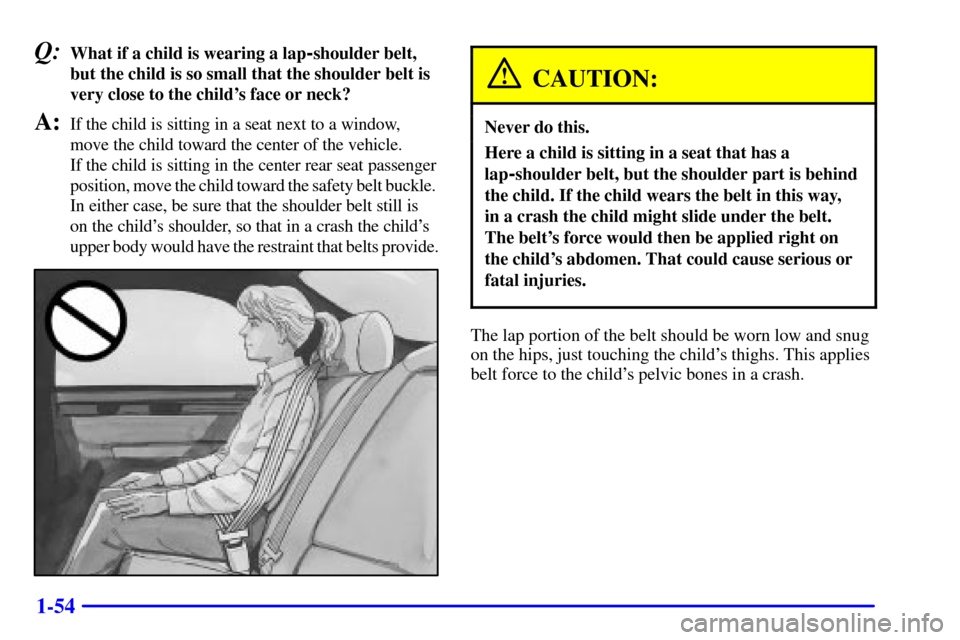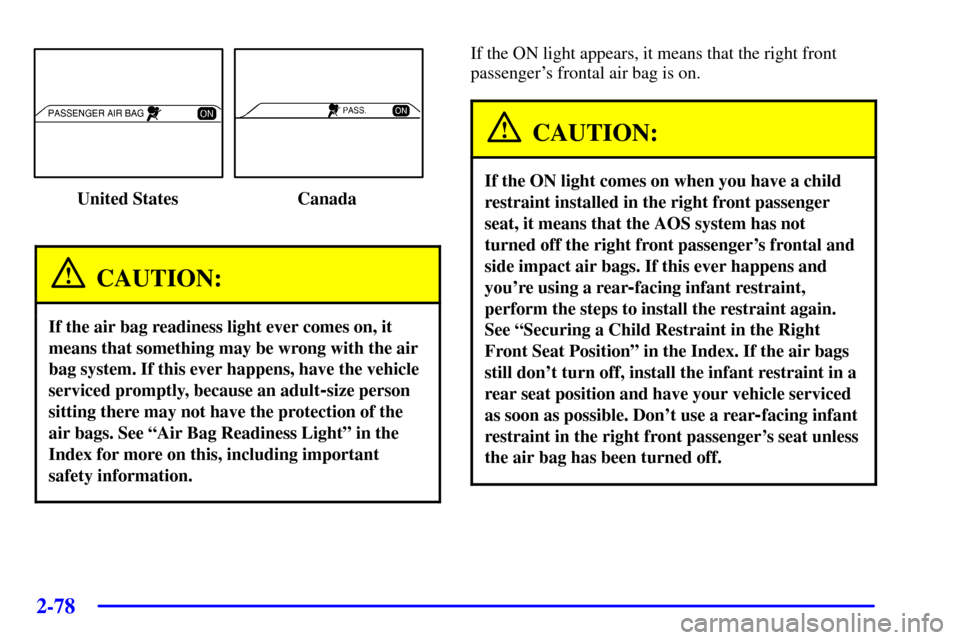Page 66 of 371

1-54
Q:What if a child is wearing a lap-shoulder belt,
but the child is so small that the shoulder belt is
very close to the child's face or neck?
A:If the child is sitting in a seat next to a window,
move the child toward the center of the vehicle.
If the child is sitting in the center rear seat passenger
position, move the child toward the safety belt buckle.
In either case, be sure that the shoulder belt still is
on the child's shoulder, so that in a crash the child's
upper body would have the restraint that belts provide.
CAUTION:
Never do this.
Here a child is sitting in a seat that has a
lap
-shoulder belt, but the shoulder part is behind
the child. If the child wears the belt in this way,
in a crash the child might slide under the belt.
The belt's force would then be applied right on
the child's abdomen. That could cause serious or
fatal injuries.
The lap portion of the belt should be worn low and snug
on the hips, just touching the child's thighs. This applies
belt force to the child's pelvic bones in a crash.
Page 145 of 371

2-78
United States Canada
CAUTION:
If the air bag readiness light ever comes on, it
means that something may be wrong with the air
bag system. If this ever happens, have the vehicle
serviced promptly, because an adult
-size person
sitting there may not have the protection of the
air bags. See ªAir Bag Readiness Lightº in the
Index for more on this, including important
safety information.
If the ON light appears, it means that the right front
passenger's frontal air bag is on.
CAUTION:
If the ON light comes on when you have a child
restraint installed in the right front passenger
seat, it means that the AOS system has not
turned off the right front passenger's frontal and
side impact air bags. If this ever happens and
you're using a rear
-facing infant restraint,
perform the steps to install the restraint again.
See ªSecuring a Child Restraint in the Right
Front Seat Positionº in the Index. If the air bags
still don't turn off, install the infant restraint in a
rear seat position and have your vehicle serviced
as soon as possible. Don't use a rear
-facing infant
restraint in the right front passenger's seat unless
the air bag has been turned off.
Page 245 of 371

4-31
CAUTION:
Do not load your vehicle any heavier than the
GVWR, or either the maximum front or rear
GAWR. If you do, parts on your vehicle can
break, and it can change the way your vehicle
handles. These could cause you to lose control
and crash. Also, overloading can shorten the life
of your vehicle.
NOTICE:
Your warranty does not cover parts or
components that fail because of overloading.
If you put things inside your vehicle -- like suitcases,
tools, packages, or anything else
-- they will go as fast
as the vehicle goes. If you have to stop or turn quickly,
or if there is a crash, they'll keep going.
CAUTION:
Things you put inside your vehicle can strike
and injure people in a sudden stop or turn,
or in a crash.
�Put things in the trunk of your vehicle. In a
trunk, put them as far forward as you can.
Try to spread the weight evenly.
�Never stack heavier things, like suitcases,
inside the vehicle so that some of them are
above the tops of the seats.
�Don't leave an unsecured child restraint in
your vehicle.
�When you carry something inside the
vehicle, secure it whenever you can.
Electronic Level Control
This feature keeps the rear of your vehicle level as the
load changes. It's automatic
-- you don't need to
adjust anything.
Page:
< prev 1-8 9-16 17-24